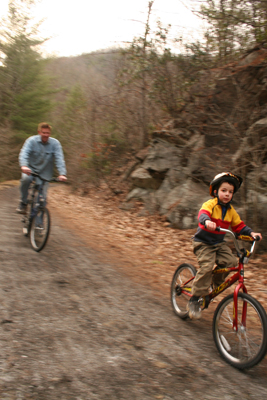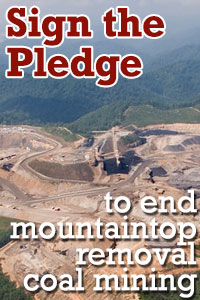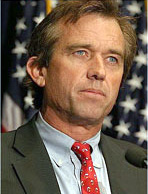WASHINGTON, Sept. 18 (UPI) — Former coal miner Ed Wiley ended his 455-mile walk from West Virginia to Washington with a plea for better legislation to protect children in coal-mining areas.
“My concern is the children,” he said last Wednesday during a news conference on Capitol Hill where he ended his walk.
Wiley is campaigning to save the lungs and lives of approximately 220 schoolchildren in the Coal River Valley, in the Appalachian Mountains, who are being made ill by mountaintop removal coal mining. The practice, which is rife in West Virginia, has been criticized by many environmentalists.
The children at Marsh Fork Elementary School, in sundial, W.Va., aged four to 11, take their classes 150 feet away from a coal preparation plant, and 400 feet below a coal-sludge dam holding back 2.8 billion gallons of toxic waste, according to a news release from Wiley.
A Mine Safety and Health Administration report, released under the Freedom of Information Act, has shown this dam to be leaking.
“This thing will break,” Wiley said of the dam.
If it did break, the children would have approximately 17 seconds to live, Wiley’s Indy media Web site said.
An independent study published by Dewey Sanderson, professor of geology at West Virginia’s Marshall University, determined that coal dust was present in all the air samples he collected from the elementary school.
“I ran my fingers along the wall at the last hearing that was at the school, about a month ago,” said Hillary Hosta, a campaigner with West Virginia’s Coal River Mountain Watch. “And they turned black with dust.”
There has been a campaign to move the school to a safer location since May 24, 2005, when two Coal River Valley residents were arrested while attempting to deliver their list of demands to the superintendent of the coal-processing plant. According to the Coal River Mountain Watch, the group’s campaign has been “systematically ignored by every government agency approached.”
There is, however, a wider issue beyond simply this school, as many of Wiley’s supporters are anxious to point out. Hosta explained to United Press International that “the school is essentially a microcosmic example of a larger swath of problems that are happening all throughout Appalachia that are inflicted by coal companies onto communities.”
According to the Energy Information Administration, the U.S. Energy Department’s data arm, in 2005 West Virginia produced 153.7 million short tons of coal, more than any other state. Coal production also creates nearly 19,000 jobs in the state. Coal is vital to West Virginia’s economy and to America as a whole, and so it is impossible to see coal production as simply a curse.
Mountaintop removal coal mining is a relatively new practice. It can destroy up to 1,000 feet of rock to reach the veins of coal underneath, and can cause leaking toxic waste and damaging coal dust. Coal must be cleaned and washed with chemicals before it goes to market, to draw out the mercury, arsenic and lead. This process leaves behind a poisonous sludge which builds up in nearby lakes, such as the one looming 400 feet above Marsh Fork Elementary.
There are 155 of these “Sludge Camps” in West Virginia. There are also nearly 400 permits to inject that sludge into underground mines, which have been known to contaminate wells.
Under the Clean Water Act (1977), the Environmental Protection Agency has the power to regulate against the contaminating of the water supply, but it has not to date brought any action against the Goals Coal plant above Marsh Fork Elementary School. Local officials affirm that the air in the school meets safety standards and say the dam is safe. But locals are not convinced.
Rep. Frank Palone, D-N.J., speaking at the Capitol Hill news conference, called it “preposterous” that the EPA allows the situation with Marsh Fork Elementary to continue.
If it were allowed under the Clean Water Act, Palone said, then the Clean Water Act must be changed. He instead supported the more stringent Clean Water Protection Act. Republicans, he said, “really haven’t done anything but tear down environmental laws.”
Prior to the news conference, Wiley met with Sen. Robert Byrd, D-W.Va., to talk about Marsh Fork Elementary school. He said Byrd “had tears in his eyes,” and had promised to “leave no stones unturned.”
While there was still clearly hard work ahead, Wiley’s walk will put pressure on the local government to help raise the money to build a new school for the children away from the coal mine.
 I think of the children,
I think of the children,















 I recall a conversation that I had with my father when I was 14 years old and he was fighting strip mining in Appalachia. There was no environmental issue about which my father cared more passionately than strip mining. He visited the Appalachian coalfields in 1966 and many times thereafter. He explained to me that the strip miners were not just destroying the environment, they were permanently impoverishing the region; there was no way that Appalachian communities could rebuild an economy from the barren moonscapes the strip industry left behind. “And,” he told me, “they are doing it to break the unions.”
I recall a conversation that I had with my father when I was 14 years old and he was fighting strip mining in Appalachia. There was no environmental issue about which my father cared more passionately than strip mining. He visited the Appalachian coalfields in 1966 and many times thereafter. He explained to me that the strip miners were not just destroying the environment, they were permanently impoverishing the region; there was no way that Appalachian communities could rebuild an economy from the barren moonscapes the strip industry left behind. “And,” he told me, “they are doing it to break the unions.” 